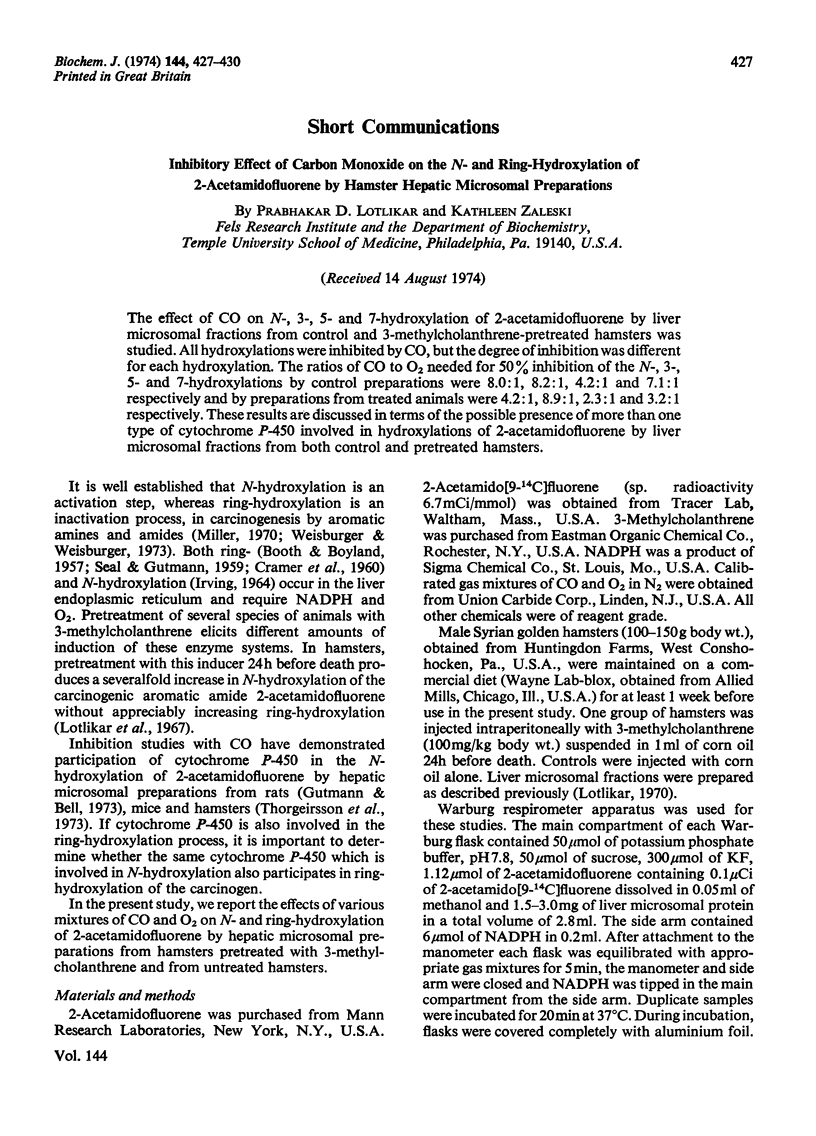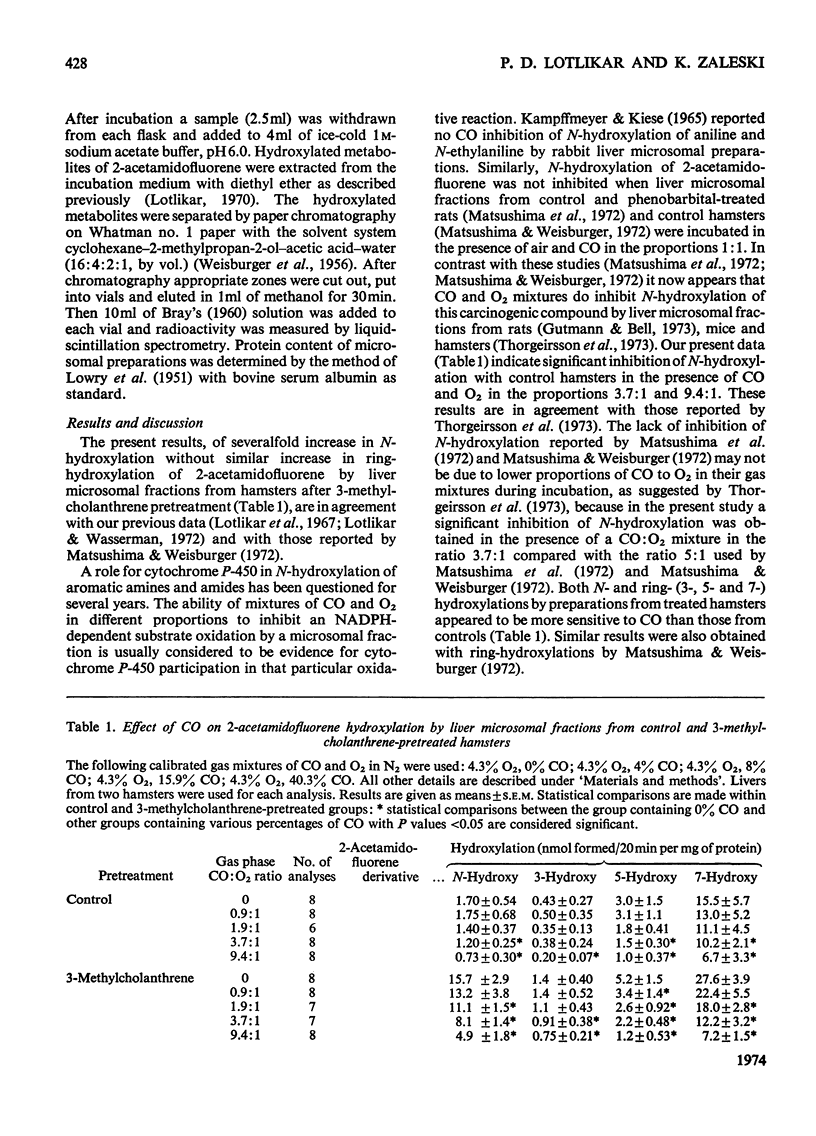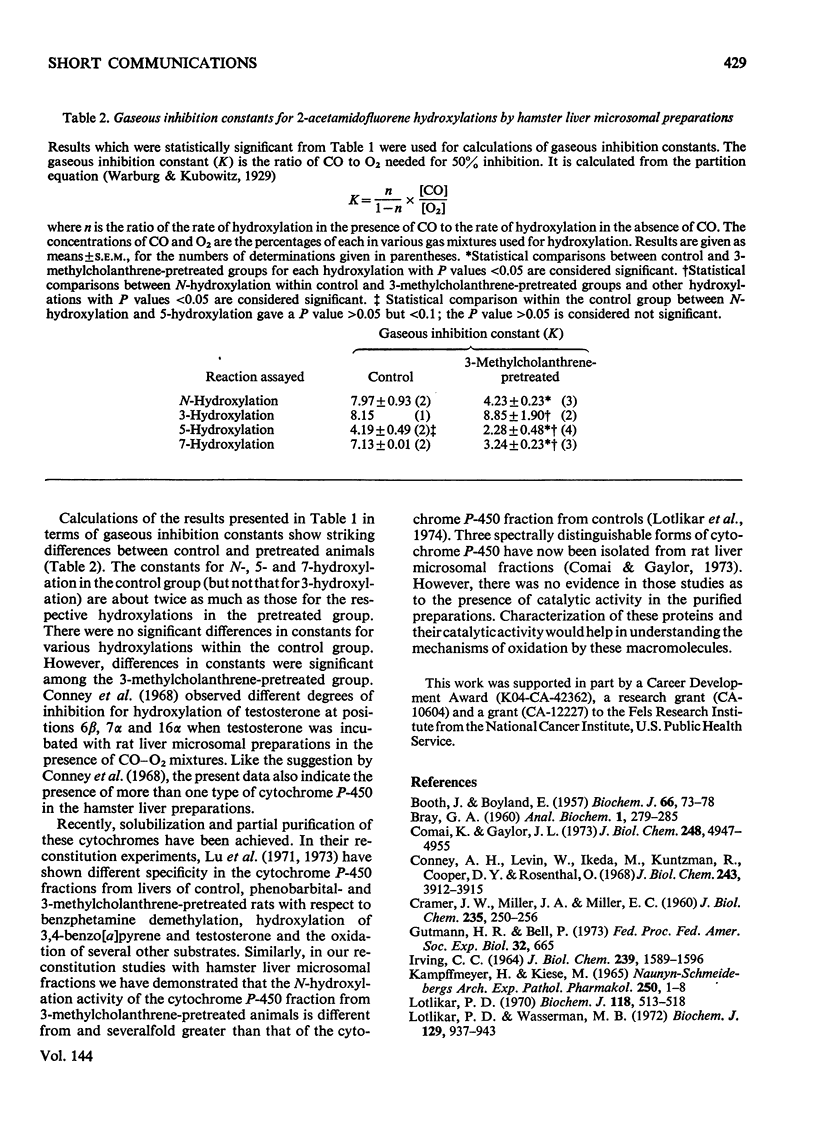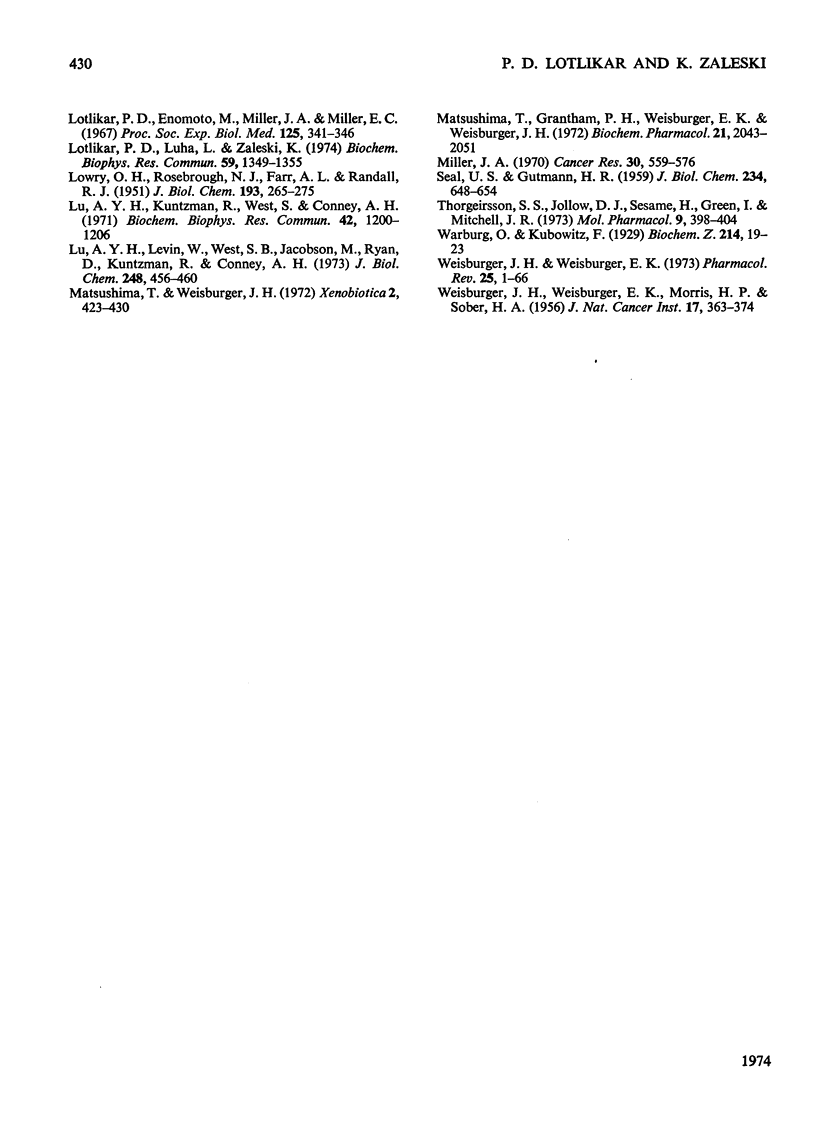Abstract
The effect of CO on N-, 3-, 5- and 7-hydroxylation of 2-acetamidofluorene by liver microsomal fractions from control and 3-methylcholanthrene-pretreated hamsters was studied. All hydroxylations were inhibited by CO, but the degree of inhibition was different for each hydroxylation. The ratios of CO to O2 needed for 50% inhibition of the N-, 3-, 5- and 7-hydroxylations by control preparations were 8.0:1, 8.2:1, 4.2:1 and 7.1:1 respectively and by preparations from treated animals were 4.2:1, 8.9:1, 2.3:1 and 3.2:1 respectively. These results are discussed in terms of the possible presence of more than one type of cytochrome P-450 involved in hydroxylations of 2-acetamidofluorene by liver microsomal fractions from both control and pretreated hamsters.
Full text
PDF



Selected References
These references are in PubMed. This may not be the complete list of references from this article.
- BOOTH J., BOYLAND E. The biochemistry of aromatic amines. III. Enzymic hydroxylation by rat-liver microsomes. Biochem J. 1957 May;66(1):73–78. doi: 10.1042/bj0660073. [DOI] [PMC free article] [PubMed] [Google Scholar]
- CRAMER J. W., MILLER J. A., MILLER E. C. The hydroxylation of the carcinogen 2-acetylaminofluorene by rat liver: stimulation by pretreatment in vivo with 3-methylcholanthrene. J Biol Chem. 1960 Jan;235:250–256. [PubMed] [Google Scholar]
- Comai K., Gaylor J. L. Existence and separation of three forms of cytochrome P-450 from rat liver microsomes. J Biol Chem. 1973 Jul 25;248(14):4947–4955. [PubMed] [Google Scholar]
- Conney A. H., Levin W., Ikeda M., Kuntzman R., Cooper D. Y., Rosenthal O. Inhibitory effect of carbon monoxide on the hydroxylation of testosterone by rat liver microsomes. J Biol Chem. 1968 Jul 25;243(14):3912–3915. [PubMed] [Google Scholar]
- IRVING C. C. ENZYMATIC N-HYDROXYLATION OF THE CARCINOGEN 2-ACETYLAMINOFLUORENE AND THE METABOLISM OF N-HYDROXY-2-ACETYLAMINOFLUORENE-9-14C IN VITRO. J Biol Chem. 1964 May;239:1589–1596. [PubMed] [Google Scholar]
- KAMPFFMEYER H., KIESE M. THE EFFECT OF CARBON MONOXIDE ON THE HYDROXYLATION OF ANILINE AND N-ETHYLANILINE BY MICROSOMAL ENZYMES. Naunyn Schmiedebergs Arch Exp Pathol Pharmakol. 1965 Feb 2;250:1–8. doi: 10.1007/BF00246877. [DOI] [PubMed] [Google Scholar]
- LOWRY O. H., ROSEBROUGH N. J., FARR A. L., RANDALL R. J. Protein measurement with the Folin phenol reagent. J Biol Chem. 1951 Nov;193(1):265–275. [PubMed] [Google Scholar]
- Lotlikar P. D. Effects of 3-methylcholanthrene pretreatment on microsomal hydroxylation of 2-acetamidofluorene by various rat hepatomas. Biochem J. 1970 Jul;118(3):513–518. doi: 10.1042/bj1180513. [DOI] [PMC free article] [PubMed] [Google Scholar]
- Lotlikar P. D., Enomoto M., Miller J. A., Miller E. C. Species variations in the N- and ring-hydroxylation of 2-acetylaminofluorene and effects of 3-methylcholanthrene pretreatment. Proc Soc Exp Biol Med. 1967 Jun;125(2):341–346. doi: 10.3181/00379727-125-32086. [DOI] [PubMed] [Google Scholar]
- Lotlikar P. D., Luha L., Zaleski K. Reconstituted hamster liver microsomal enzyme system for N-hydroxylation of the carcinogen 2-acetylaminofluorene. Biochem Biophys Res Commun. 1974 Aug 19;59(4):1349–1355. doi: 10.1016/0006-291x(74)90462-8. [DOI] [PubMed] [Google Scholar]
- Lotlikar P. D., Wasserman M. B. Effects of safrole and isosafrole pretreatment on N- and ring-hydroxylation of 2-acetamidofluorene by the rat and hamster. Biochem J. 1972 Oct;129(4):937–943. doi: 10.1042/bj1290937. [DOI] [PMC free article] [PubMed] [Google Scholar]
- Lu A. Y., Kuntzman R., West S., Conney A. H. Reconstituted liver microsomal enzyme system that hydroxylates drugs, other foreign compounds and endogenous substrates. I. Determination of substrate specificity by the cytochrome P-450 and P-448 fractions. Biochem Biophys Res Commun. 1971 Mar 19;42(6):1200–1206. doi: 10.1016/0006-291x(71)90033-7. [DOI] [PubMed] [Google Scholar]
- Lu A. Y., Levin W., West S. B., Jacobson M., Ryan D., Kuntzman R., Conney A. H. Reconstituted liver microsomal enzyme system that hydroxylates drugs, other foreign compounds, and endogenous substrates. VI. Different substrate specificities of the cytochrome P450 fractions from control and phenobarbital-treated rats. J Biol Chem. 1973 Jan 25;248(2):456–460. [PubMed] [Google Scholar]
- MORRIS H. P., SOBER H. A., WEISBURGER E. K., WEISBURGER J. H. Chromatographic separation of some metabolites of the carcinogen N-2-fluorenylacetamide. J Natl Cancer Inst. 1956 Sep;17(3):363–374. [PubMed] [Google Scholar]
- Matsushima T., Grantham P. H., Weisburger E. K., Weisburger J. H. Phenobarbital-mediated increase in ring- and N-hydroxylation of the carcinogen N-2-fluorenylacetamide, and decrease in amounts bound to liver deoxyribonucleic acid. Biochem Pharmacol. 1972 Aug 1;21(15):2043–2051. doi: 10.1016/0006-2952(72)90158-x. [DOI] [PubMed] [Google Scholar]
- Matsushima T., Weisburger J. H. Effect of carbon monoxide or of 3-aminotriazole on C-and N-hydroxylation of the carcinogen N-2-fluorenylacetamide by liver microsomes of hamsters pretreated with 3-methylcholanthrene. Xenobiotica. 1972 Sep;2(5):423–430. doi: 10.3109/00498257209111070. [DOI] [PubMed] [Google Scholar]
- Miller J. A. Carcinogenesis by chemicals: an overview--G. H. A. Clowes memorial lecture. Cancer Res. 1970 Mar;30(3):559–576. [PubMed] [Google Scholar]
- SEAL U. S., GUTMANN H. R. The metabolism of the carcinogen N-(2-fluorenyl) acetamide by liver cell fractions. J Biol Chem. 1959 Mar;234(3):648–654. [PubMed] [Google Scholar]
- Thorgeirsson S. S., Jollow D. J., Sasame H. A., Green I., Mitchell J. R. The role of cytochrome P-450 in N-hydroxylation of 2-acetylaminofluorene. Mol Pharmacol. 1973 May;9(3):398–404. [PubMed] [Google Scholar]
- Weisburger J. H., Weisburger E. K. Biochemical formation and pharmacological, toxicological, and pathological properties of hydroxylamines and hydroxamic acids. Pharmacol Rev. 1973 Mar;25(1):1–66. [PubMed] [Google Scholar]


